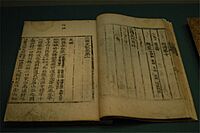Samguk sagi facts for kids
 |
|
| Author | Kim Bu-sik |
|---|---|
| Original title | 삼국사기 (三國史記) |
| Country | Goryeo |
| Language | Classical Chinese |
| Subject | History of Korea |
| Genre | Ancient history |
|
Publication date
|
1145 |
The Samguk sagi (Hangul: 삼국사기; Hanja: 三國史記) is a very old history book from Korea. It tells the story of three ancient Korean kingdoms: Goguryeo, Baekje, and Silla. This important book was finished in the year 1145. It is the oldest history book about Korea that we still have today.
The Samguk sagi was written in Classical Chinese. This was the formal written language used by educated people in ancient Korea. King Injong of Goryeo (who ruled from 1122 to 1146) asked for this book to be created. A government official and historian named Kim Bu-sik led a team of younger scholars to write it. Today, you can find a digital version of this book online. It even has a modern Korean translation in Hangul, which is the Korean alphabet.
Contents
Why the Samguk Sagi is Important
The Samguk sagi is super important for learning about Korean history. It covers the time of the Three Kingdoms and the later Unified Silla period. This book, along with another one called Samguk yusa, are the only old Korean sources left from that time. The Samguk sagi has a lot of information and details. It helps us understand what life was like back then.
Why This History Book Was Written
There were a few big reasons why the Samguk sagi was put together in the 1100s. These reasons were about ideas and politics. Kim Bu-sik, the main historian, wrote about these reasons in the book's introduction.
He said that many scholars and important officials knew a lot about Chinese history and old writings. But, they didn't know much about their own country's history. Kim Bu-sik thought this was a real shame. He wanted Koreans to learn about their own past. He believed that knowing their history would help them be proud of their country and learn from past events.
Where the Information Came From
The Samguk sagi was based on older history books. One main source was the Gu Samguksa (which means "Old History of the Three Kingdoms"). Other old records, like the Hwarang Segi (Annals of Hwarang), were also used. Sadly, most of these older books don't exist anymore.
The authors of Samguk sagi did not use Japanese history books, like the Kojiki or Nihon Shoki. Maybe Kim Bu-sik didn't know about them, or he chose not to use them. However, he used many Chinese history books. Some of the main Chinese sources he used were the Wei shu (Book of Wei), Sanguo Zhi, Jin Shu, Jiu Tangshu, Xin Tangshu, and the Zizhi Tongjian.
What's Inside the Samguk Sagi
The Samguk sagi is made up of 50 different books, or "scrolls." Each scroll covers a different part of history or a different topic. Here's how the books are organized:
Silla's Records
There are 12 scrolls about the history of the Silla kingdom. These books tell the stories of Silla's kings and queens.
- Hyeokgeose, the first ruler of Silla.
- Queen Seondeok, a famous queen.
- King Taejong Muyeol, who helped unify the kingdoms.
- King Munmu, who finished the unification.
- And many other kings and queens of Silla.
Goguryeo's Records
There are 10 scrolls about the history of the Goguryeo kingdom. These books tell about the rulers of Goguryeo.
- King Dongmyeong, the founder of Goguryeo.
- King Taejo, a powerful early king.
- King Gwanggaeto, a great conqueror.
- King Jangsu, who ruled for a very long time.
- And many other kings of Goguryeo.
Baekje's Records
There are 6 scrolls about the history of the Baekje kingdom. These books describe the kings of Baekje.
- King Onjo, the founder of Baekje.
- King Geunchogo, who expanded Baekje's power.
- King Seong, who tried to revive Baekje.
- And many other kings of Baekje.
Chronological Tables
These 3 scrolls are like big timelines. They list important events and rulers from all three kingdoms side-by-side. This helps historians see what happened at the same time in different kingdoms.
Monographs
These 9 scrolls cover specific topics. They are not just about kings, but about how society worked.
- Books about ancient Korean customs, like rites and music.
- Details about vehicles, clothing, and homes.
- Information about the geography of Silla, including old territories of Goguryeo and Baekje.
- Descriptions of government offices in Silla.
Biographies
These 10 scrolls tell the life stories of important people. These are not just kings, but also generals, scholars, and other famous figures.
- Kim Yusin: A famous general from Silla.
- Eulji Mundeok: A brilliant general from Goguryeo.
- Ch'oe Ch'i-wŏn: A famous scholar from Silla.
- Gyebaek: A brave general from Baekje.
- Yeon Gaesomun: A powerful military leader from Goguryeo.
- And many other interesting people who shaped Korean history.
See also
- Samguk Yusa
- Goryeo-sa
- Annals of Joseon Dynasty
- Rulers of Korea
- Placename glosses in the Samguk sagi


